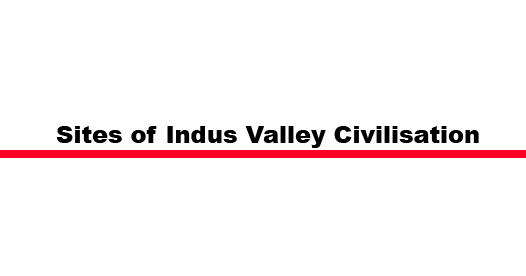
In recent years archaeological excavation have been carried on at Mohenjodaro in the Larkana district, Sind and at Harappa in the Montgomery district of the Punjab.
There are smaller trial excavations at various other sites in Sind, Baluchistan, Punjab and even further east and south, have proved beyond doubt that some four or five thousand years ago a highly civilised community flourished in these region.
The Indus valley takes its rank with the valleys of the Nile, the Tigris and the Euphrates as having contributed to the most ancient phase of human civilisation of which we are yet aware.
Sir John Marshall was the 1st person to use the term Indus civilisation. The Indus civilisation belongs to the Chalcolithic or Bronze Age since the objects were found at the various sites of this civilisation, nearly Harappan sites are so far known to us.
They belong to the early, mature and late phases of Harappan culture. Some of the noteworthy sites which have been excavated are :-
Harappa (1921) by Dayaram Sahni
Mahenjodaro (1922) by R.D.Banerjee
Dholavira (1967-68) by J.P.Joshi and (1990-91) by R.S.Bisht
Kalibangan by Dr. A.L.Ghosh (1969)
Lothal (1955-63), Chanhu daro, Banawali
The harappan culture existed between 2500BC and 1800BC. Its mature phase lay between 2200Bc and 2000BC.
The advent of radiocarbon dating has provided a new source of information in fixing the Harappan chronology.
Indus valley civilisation was the largest cultural zone of the period- the area covered by it (about 1.3million sq.km.) being much greater than that of other contemporary civilisation. Over 1000 sites have discovered so far.
It extends from Ropar, almost impinging upon the sub Himalayan foot hills in the north to Daimabad in the Ahmadnagar districts of Maharastra in the south, and form Sutkagendor (on the sea-coast of south balchistan) in the west to Alamgirpur (in the upper Ganga-Yamuna doab, U.P.) in the east.
The only definite material with regard to the people of the Indus valley civilisation are the human skeleton and the skulls found among the ruins, which show that the population of the Mohenjodaro was homogenous and comprised of at least 4 different racial types viz, proto-australiod, Mediterranean, alpinoid and mongoloid.
The excavated Indus cities may be classified into the following groups 1) nucleus cities(Harappa, mohenjodaro, dholavira, kalibangan) 2) coastal towns (lothal, sukangendor, balakot, allahdino) 3) other cities and towns.(surkotada, banawali, chanhudaro, kot diji).
Harappa
It was the 1st Indus site to be discovered and excavated by Daya ram Sahani. The site has 2 large and imposing ruined mounds located some 25kms. South-west of Montgomery district of Punjab on the left bank of river Ravi. Alexander canninghum identified Harappa with po-fa-to or po-fa-to-do visited by Hiuen-tsang.
•The western mound of Harappa, smaller in size represented the citadel, parallelogram in plan and fortified.
•Outside the citadel was the unfortified town having some important structures identified with workmens’ quarters, working fllors and granaries.
•The workmens’ quarters, 10 in number were of uniform size and sace. Close to these quarters 16furnaces, pear shaped on plan with cowdung ash and charcoal.
•12 granaries were found systematically in 2 rows.
•891 seals which form 36.3% of the total writing material of the Indus civilisation.
•2 very important stone figurines which included one red stone torso of a naked male figure and a female figure in dancing pose.
•A crucible used for smelting bronze was also found at a slightly higher level.
Evidence of the disposal of the dead have been found to the south of the citadel. The skeletons were disposed of in the graves along with the grave-goods.
Mohenjodaro
The site of Mohenjodaro (he mound of dead) situated in the Larkana districts of sind and the right bank of the river Indus. It has 2 mounds, the western being the citadel and the eastern extensive mound was enshrining the relics of the buried lower city, the mounds were excavated by Sir John Marshall.
•The most important public place seems to be the great bath made of bitumen and a system of supplying and draining away water.
•The largest building is the great granary and lies to the west of the great bath.
•About 1398 seals were discovered.
•Some stone images were found. Like the torso of a priest made of steatite, lime stone male head, the seated male of alabaster, the seated male with the hands placed on the knees, and a composite animal figure made up of limestone.
•The bronze dancing girl from Mahenjodaro , considered a masterpiece is made by cast wax technique.
Kalibangan
Situated in Ganganagar district of Rajasthan on the southern bank of the Ghaggar River. This site also had 2 parts. Citadel and lower towns.
•The citadel and the lower town both were fortified.
•The citadel had mud-brick platforms having 7 fire alters in a row.
•The lower fortified town had 2 gateways.
•The people used mud-bricks for the construction of houses, the use of burnt bricks has been found only in wells, drains and pavements.
•The discovery of inscribed shreds clearly suggests that the Indus script was written from right to left.
•Evidence of ploughed field was also discovered.



Join The Discussion